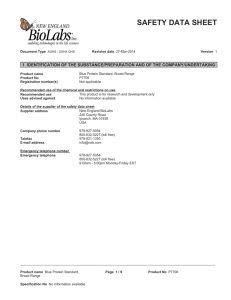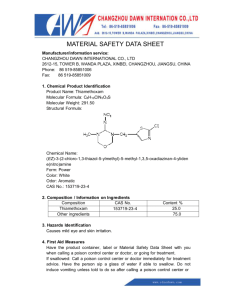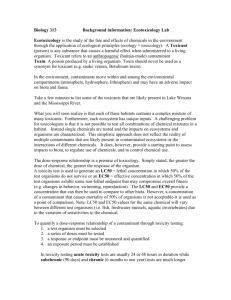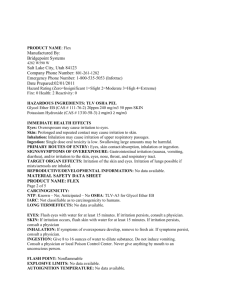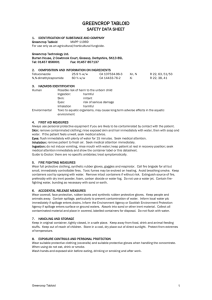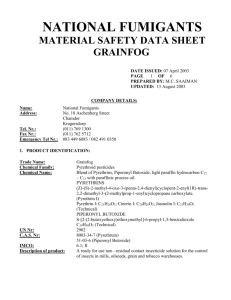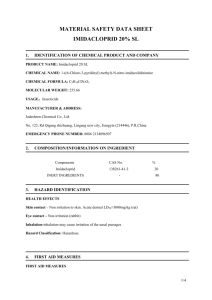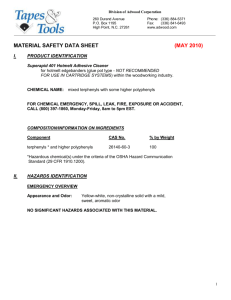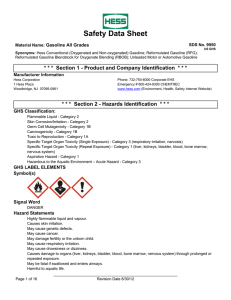7135 AMERLOCK 400 C _ 400 GFA CURE (English (GB)) AMERON
advertisement
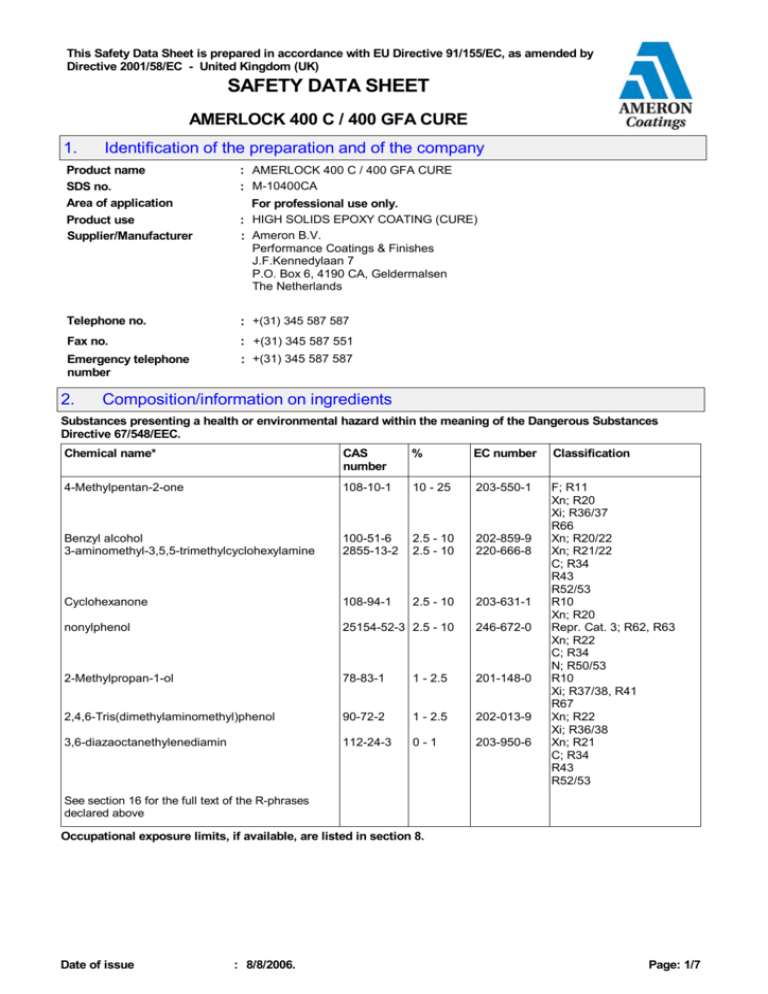
This Safety Data Sheet is prepared in accordance with EU Directive 91/155/EC, as amended by Directive 2001/58/EC - United Kingdom (UK) SAFETY DATA SHEET AMERLOCK 400 C / 400 GFA CURE 1. Identification of the preparation and of the company Product name SDS no. Area of application Product use Supplier/Manufacturer : AMERLOCK 400 C / 400 GFA CURE : M-10400CA Telephone no. : +(31) 345 587 587 Fax no. : +(31) 345 587 551 Emergency telephone number : +(31) 345 587 587 2. For professional use only. : HIGH SOLIDS EPOXY COATING (CURE) : Ameron B.V. Performance Coatings & Finishes J.F.Kennedylaan 7 P.O. Box 6, 4190 CA, Geldermalsen The Netherlands Composition/information on ingredients Substances presenting a health or environmental hazard within the meaning of the Dangerous Substances Directive 67/548/EEC. Chemical name* CAS number % EC number Classification 4-Methylpentan-2-one 108-10-1 10 - 25 203-550-1 Benzyl alcohol 3-aminomethyl-3,5,5-trimethylcyclohexylamine 100-51-6 2855-13-2 2.5 - 10 2.5 - 10 202-859-9 220-666-8 Cyclohexanone 108-94-1 2.5 - 10 203-631-1 nonylphenol 25154-52-3 2.5 - 10 246-672-0 2-Methylpropan-1-ol 78-83-1 1 - 2.5 201-148-0 2,4,6-Tris(dimethylaminomethyl)phenol 90-72-2 1 - 2.5 202-013-9 3,6-diazaoctanethylenediamin 112-24-3 0-1 203-950-6 F; R11 Xn; R20 Xi; R36/37 R66 Xn; R20/22 Xn; R21/22 C; R34 R43 R52/53 R10 Xn; R20 Repr. Cat. 3; R62, R63 Xn; R22 C; R34 N; R50/53 R10 Xi; R37/38, R41 R67 Xn; R22 Xi; R36/38 Xn; R21 C; R34 R43 R52/53 See section 16 for the full text of the R-phrases declared above Occupational exposure limits, if available, are listed in section 8. Date of issue : 8/8/2006. Page: 1/7 AMERLOCK 400 C / 400 GFA CURE 3. Hazards identification The preparation is classified as dangerous according to Directive 1999/45/EC and its amendments. Classification : R10 Xn; R20/22 Xi; R38, R41 R43 N; R51/53 Physical/chemical hazards : Flammable. Human health hazards Environmental hazards 4. First-aid measures First-aid measures General Inhalation Skin contact Eye contact Ingestion 5. : In all cases of doubt, or when symptoms persist, seek medical attention. Never give anything by mouth to an unconscious person. : Remove to fresh air. Keep person warm and at rest. If not breathing, if breathing is irregular or if respiratory arrest occurs, provide artificial respiration or oxygen by trained personnel. Give nothing by mouth. If unconscious, place in recovery position and seek medical advice. : Remove contaminated clothing and shoes. Wash skin thoroughly with soap and water or use recognised skin cleanser. Do not use solvents or thinners. : Check for and remove any contact lenses. Immediately flush eyes with running water for at least 15 minutes, keeping eyelids open. : If swallowed, seek medical advice immediately and show the container or label. Keep person warm and at rest. Do not induce vomiting. Fire-fighting measures Extinguishing media Recommendations 6. : Harmful by inhalation and if swallowed. Irritating to skin. Risk of serious damage to eyes. May cause sensitisation by skin contact. : Toxic to aquatic organisms. May cause long-term adverse effects in the aquatic environment. : Recommended: alcohol-resistant foam, CO2, powders, water spray. Not to be used : water jet. : Fire will produce dense black smoke. Exposure to decomposition products may cause a health hazard. Appropriate breathing apparatus may be required. Cool closed containers exposed to fire with water. Do not release runoff from fire to sewers or waterways. Accidental release measures : Exclude sources of ignition and ventilate the area. Avoid breathing vapour or mist. Refer to protective measures listed in sections 7 and 8. Spill : Contain and collect spillage with non-combustible, absorbent material e.g. sand, earth, vermiculite or diatomaceous earth and place in container for disposal according to local regulations (see section 13). Do not allow to enter drains or watercourses. Preferably clean with a detergent. Avoid using solvents. If the product contaminates lakes, rivers, or sewers, inform the appropriate authorities in accordance with local regulations. Note: see section 8 for personal protective equipment and section 13 for waste disposal. Personal precautions 7. Handling and storage Handling : Vapours are heavier than air and may spread along floors. Vapours may form explosive mixtures with air. Prevent the creation of flammable or explosive concentrations of vapours in air and avoid vapour concentrations higher than the occupational exposure limits. In addition, the product should only be used in areas from which all naked lights and other sources of ignition have been excluded. Electrical equipment should be protected to the appropriate standard. To dissipate static electricity during transfer, earth drum and connect to receiving container with bonding strap. Operators should wear antistatic footwear and clothing and floors should be of the conducting type. Date of issue : 8/8/2006. Page: 2/7 7. AMERLOCK 400 C / 400 GFA CURE Handling and storage Keep container tightly closed. Keep away from heat, sparks and flame. No sparking tools should be used. Avoid contact with skin and eyes. Avoid the inhalation of dust, particulates, spray or mist arising from the application of this preparation. Avoid inhalation of dust from sanding. Eating, drinking and smoking should be prohibited in area where this material is handled, stored and processed. Workers should wash hands and face before eating, drinking and smoking. Put on appropriate personal protective equipment (see section 8). Never use pressure to empty. Container is not a pressure vessel. Always keep in containers made from the same material as the original one. Comply with the health and safety at work laws. Storage When operators, whether spraying or not, have to work inside the spray booth, ventilation is unlikely to be sufficient to control particulates and solvent vapour in all cases. In such circumstances they should wear a compressed air-fed respirator during the spraying process and until such time as the particulates and solvent vapour concentration has fallen below the exposure limits. : Store in accordance with local regulations. Observe label precautions. Store between 5 to 40°C (41 to 104°F). Store in a cool, well-ventilated area away from incompatible materials and ignition sources. Keep away from: oxidising agents, strong alkalis, strong acids. No smoking. Prevent unauthorised access. Containers that have been opened must be carefully resealed and kept upright to prevent leakage. Do not empty into drains.. 8. Exposure controls/personal protection Engineering measures Ingredient name 4-Methylpentan-2-one Cyclohexanone 2-Methylpropan-1-ol : Provide adequate ventilation. Where reasonably practicable, this should be achieved by the use of local exhaust ventilation and good general extraction. If these are not sufficient to maintain concentrations of particulates and solvent vapours below the OEL, suitable respiratory protection must be worn. Occupational exposure limits EH40-WEL (United Kingdom (UK), 1/2005). Skin STEL: 416 mg/m3 15 minute/minutes. Form: All forms STEL: 100 ppm 15 minute/minutes. Form: All forms TWA: 208 mg/m3 8 hour/hours. Form: All forms TWA: 50 ppm 8 hour/hours. Form: All forms EH40-WEL (United Kingdom (UK), 1/2005). Skin STEL: 20 ppm 15 minute/minutes. Form: All forms TWA: 10 ppm 8 hour/hours. Form: All forms EH40-WEL (United Kingdom (UK), 1/2005). STEL: 231 mg/m3 15 minute/minutes. Form: All forms STEL: 75 ppm 15 minute/minutes. Form: All forms TWA: 154 mg/m3 8 hour/hours. Form: All forms TWA: 50 ppm 8 hour/hours. Form: All forms Personal protective equipment Respiratory system : If workers are exposed to concentrations above the exposure limit, they must use appropriate, certified respirators. Skin and body : Personnel should wear antistatic clothing made of natural fibres or of hightemperature-resistant synthetic fibres. Hands Gloves : For prolonged or repeated handling, use gloves: nitrile. Barrier creams may help to protect the exposed areas of the skin but should not be applied once exposure has occurred. Date of issue : 8/8/2006. Page: 3/7 AMERLOCK 400 C / 400 GFA CURE Exposure controls/personal protection 8. The user must check that the final choice of type of glove selected for handling this product is the most appropriate and takes into account the particular conditions of use, as included in the user's risk assessment. Eyes : Use safety eyewear designed to protect against splash of liquids. Environmental exposure controls Do not allow to enter drains or watercourses. 9. Physical and chemical properties Physical state Odour Flash point Viscosity Relative density Vapour density Solubility Auto-ignition temperature 10. : Liquid. : Characteristic. : Closed cup: 26°C (78.8°F). (Setaflash.) : 60000 - 100000 mPa.s @ 25°C ASTM D-2196 : 1.369 g/cm3 (25°C / 77°F) : >1 (Air = 1) : Insoluble in cold water, hot water. : The lowest known value is 414.85°C (778.7°F) (2-Methylpropan-1-ol). Stability and reactivity Stable under recommended storage and handling conditions (see section 7). Hazardous decomposition products: carbon monoxide, carbon dioxide, smoke, oxides of nitrogen. Keep away from the following materials to prevent strong exothermic reactions: oxidising agents, strong alkalis, strong acids. 11. Toxicological information There is no data available on the preparation itself. The preparation has been assessed following the conventional method of the Dangerous Preparations Directive 1999/45/EC and classified for toxicological hazards accordingly. See sections 2 and 15 for details. Exposure to component solvent vapour concentrations in excess of the stated occupational exposure limit may result in adverse health effects such as mucous membrane and respiratory system irritation and adverse effects on the kidneys, liver and central nervous system. Solvents may cause some of the above effects by absorption through the skin. Symptoms and signs include headache, dizziness, fatigue, muscular weakness, drowsiness and, in extreme cases, loss of consciousness. Repeated or prolonged contact with the preparation may cause removal of natural fat from the skin, resulting in non-allergic contact dermatitis and absorption through the skin. If splashed in the eyes, the liquid may cause irritation and reversible damage. Contains (3-aminomethyl-3,5,5-trimethylcyclohexylamine, 3,6-diazaoctanethylenediamin). May produce an allergic reaction. 12. Ecological information There is no data available on the preparation itself. Do not allow to enter drains or watercourses. The preparation has been assessed following the conventional method of the Dangerous Preparations Directive 1999/45/EC and is classified for eco-toxicological properties accordingly. See Sections 2 and 15 for details. Ecotoxicity data Product/ingredient name Species Period Result 4-Methylpentan-2-one Scenedesmus subspicatus 48 hour/hours 980 mg/l (EC50) Scenedesmus subspicatus 48 hour/hours 2000 mg/l (EC50) Pimephales promelas (LC50) 96 hour/hours 505 mg/l Pimephales promelas (LC50) 96 hour/hours 537 mg/l Pimephales promelas (LC50) 96 hour/hours 540 mg/l Benzyl alcohol Lepomis macrochirus (LC50) 96 hour/hours 10 mg/l Pimephales promelas (LC50) 96 hour/hours 460 mg/l 3-aminomethyl-3,5,5Daphnia magna (EC50) 48 hour/hours 17.4 mg/l trimethylcyclohexylamine Date of issue : 8/8/2006. Page: 4/7 12. AMERLOCK 400 C / 400 GFA CURE Ecological information Cyclohexanone Pimephales promelas (LC50) Pimephales promelas (LC50) Pimephales promelas (LC50) Daphnia magna (EC50) Daphnia magna (EC50) Pimephales promelas (LC50) Pimephales promelas (LC50) Lepomis macrochirus (LC50) Oncorhynchus mykiss (LC50) Scenedesmus subspicatus (EC50) Daphnia pulex (EC50) Scenedesmus subspicatus (EC50) Oncorhynchus mykiss (LC50) Pimephales promelas (LC50) Pimephales promelas (LC50) nonylphenol 2-Methylpropan-1-ol 13. 96 hour/hours 96 hour/hours 96 hour/hours 48 hour/hours 48 hour/hours 96 hour/hours 96 hour/hours 96 hour/hours 96 hour/hours 527 mg/l 630 mg/l 732 mg/l 0.0848 mg/l 0.19 mg/l 0.128 mg/l 0.135 mg/l 0.209 mg/l 0.221 mg/l 48 hour/hours 230 mg/l 48 hour/hours 48 hour/hours 1100 mg/l 1250 mg/l 96 hour/hours 1330 mg/l 96 hour/hours 96 hour/hours 1430 mg/l 1510 mg/l Disposal considerations Do not allow to enter drains or watercourses. Dispose of according to all federal, state and local applicable regulations. Hazardous waste : The classification of the product may meet the criteria for a hazardous waste. 14. Transport information Tr anspor twi t hi nuser ’ spr emi ses:always transport in closed containers that are upright and secure. Ensure that persons transporting the product know what to do in the event of an accident or spillage. Land - road/railway UN number : UN1263 Transport document name : Paint related material. Special provision 640 : E ADR/RID Class : 3 HI/Kemler number : 30 Packing group : III ADR/RID Label : Exempted according to 2.2.3.1.5 (Viscous substance exemption) 3 Sea UN number Proper shipping name IMDG Class Packing group IMDG Label : : : : : UN1263 Paint related material. 3 III Exempted according to 2.3.2.5 (Viscous substance exemption) 3 Marine pollutant Emergency schedules (EmS) Air UN number Proper shipping name ICAO/IATA Classification : No. : F-E, S-E Date of issue : 8/8/2006. : UN1263 : Paint related material. : 3 Page: 5/7 14. AMERLOCK 400 C / 400 GFA CURE Transport information Packing group ICAO/IATA label : III : 3 15. Regulatory information EU regulations Hazard symbol/symbols : The product is classified and labelled for supply in accordance with the Directive 1999/45/EC as follows: : Risk phrases : Safety phrases : Contains Industrial use : : 16. Harmful, Dangerous for the environment. R10- Flammable. R20/22- Harmful by inhalation and if swallowed. R38- Irritating to skin. R41- Risk of serious damage to eyes. R43- May cause sensitisation by skin contact. R51/53- Toxic to aquatic organisms, may cause long-term adverse effects in the aquatic environment. S23- Do not breathe vapour / spray. S24- Avoid contact with skin. S26- In case of contact with eyes, rinse immediately with plenty of water and seek medical advice. S37/39- Wear suitable gloves and eye/face protection. S51- Use only in well-ventilated areas. 3-aminomethyl-3,5,5-trimethylcyclohexylamine Thei nf or mat i oncont ai nedi nt hi ss af et ydat as heetdoesnotcons t i t ut et heus er ’ s own assessment of workplace risks, as required by other health and safety legislation. The provisions of the national health and safety at work regulations apply to the use of this product at work. Other information CEPE Classification Full text of R-phrases referred to in sections 2 and 3 - United Kingdom (UK) : 1 : R11- Highly flammable. R10- Flammable. R62- Possible risk of impaired fertility. R63- Possible risk of harm to the unborn child. R20- Harmful by inhalation. R20/22- Harmful by inhalation and if swallowed. R21- Harmful in contact with skin. R21/22- Harmful in contact with skin and if swallowed. R22- Harmful if swallowed. R34- Causes burns. R36/37- Irritating to eyes and respiratory system. R36/38- Irritating to eyes and skin. R37/38- Irritating to respiratory system and skin. R38- Irritating to skin. R41- Risk of serious damage to eyes. R43- May cause sensitisation by skin contact. R66- Repeated exposure may cause skin dryness or cracking. R67- Vapours may cause drowsiness and dizziness. R50/53- Very toxic to aquatic organisms, may cause long-term adverse effects in the aquatic environment. R51/53- Toxic to aquatic organisms, may cause long-term adverse effects in the aquatic environment. R52/53- Harmful to aquatic organisms, may cause long-term adverse effects in the aquatic environment. The information in this Safety Data Sheet is required pursuant to EU Directive 91/155/EEC and its amendments. Date of issue : 8/8/2006. Page: 6/7 16. AMERLOCK 400 C / 400 GFA CURE Other information : 31/8/2006. Date of printing : 8/8/2006. Date of issue Version : 3 Notice to reader The information in this SDS is based on the present state of our knowledge and on current laws. The product is not to be used for purposes other than those specified under section 1 without first obtaining written handling instructions. It is always the responsibility of the user to take all necessary steps to fulfil the demands set out in the local rules and legislation. The information in this SDS is meant to be a description of the safety requirements for our product. It is not to be considered a guarantee of the product's properties. Date of issue : 8/8/2006. Page: 7/7
